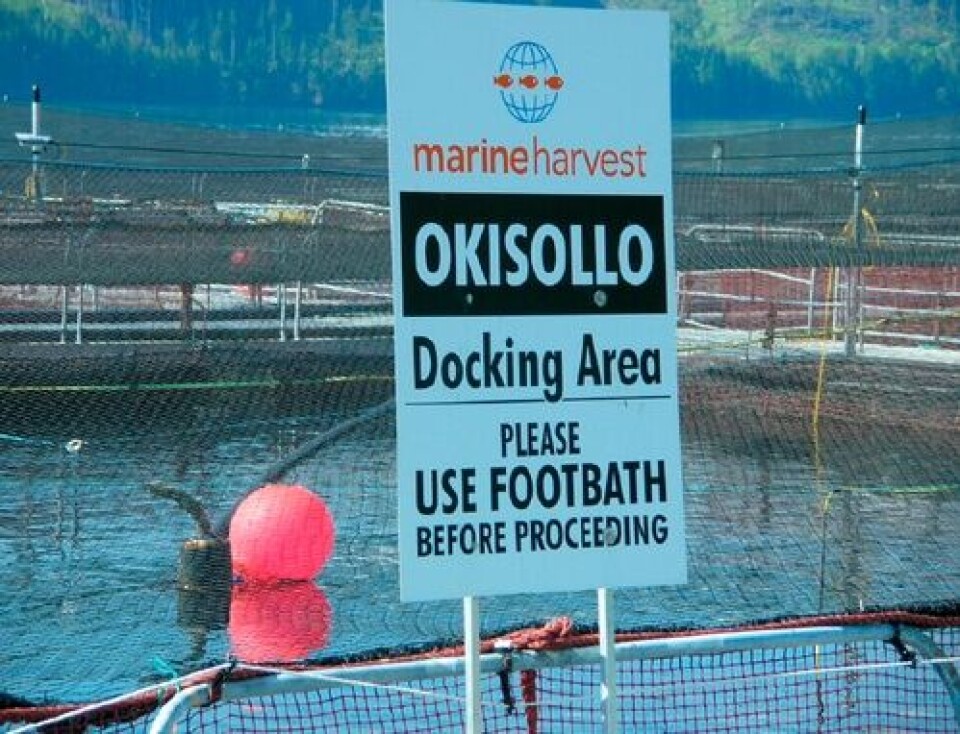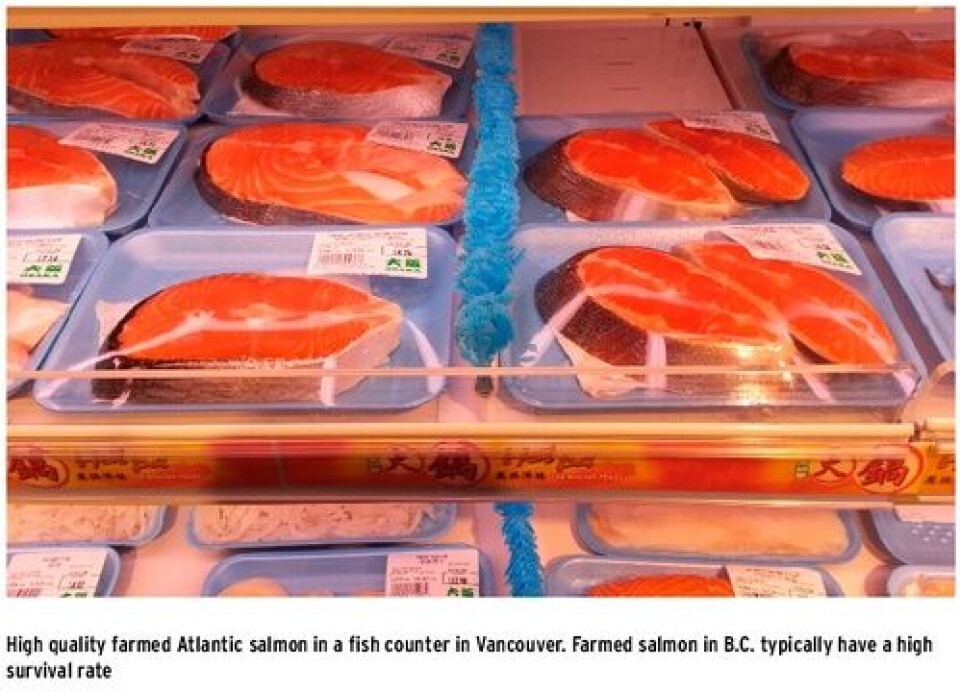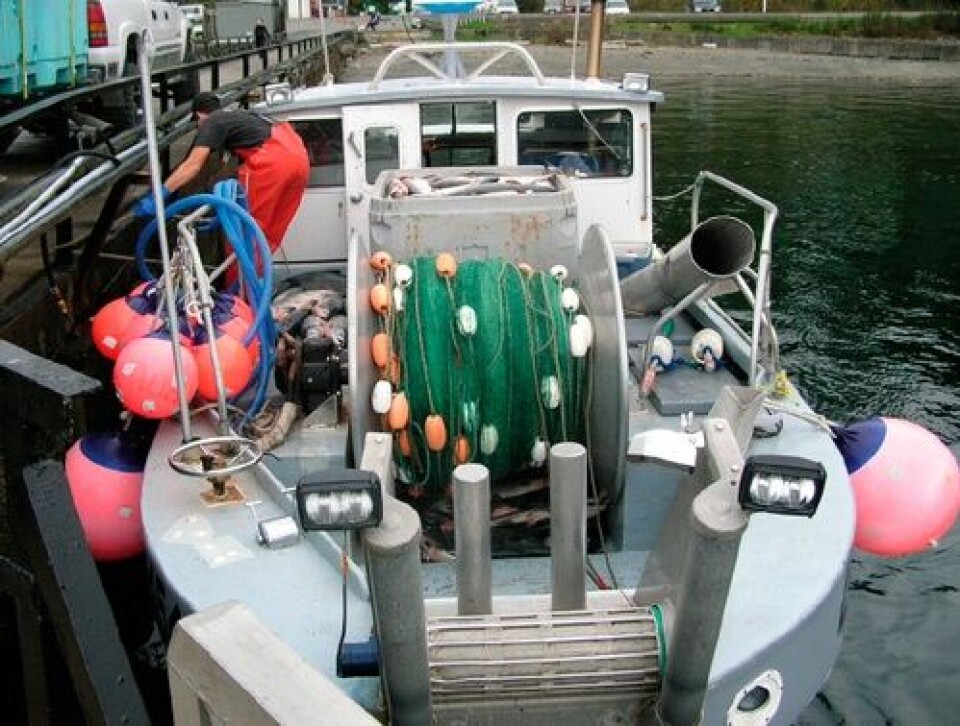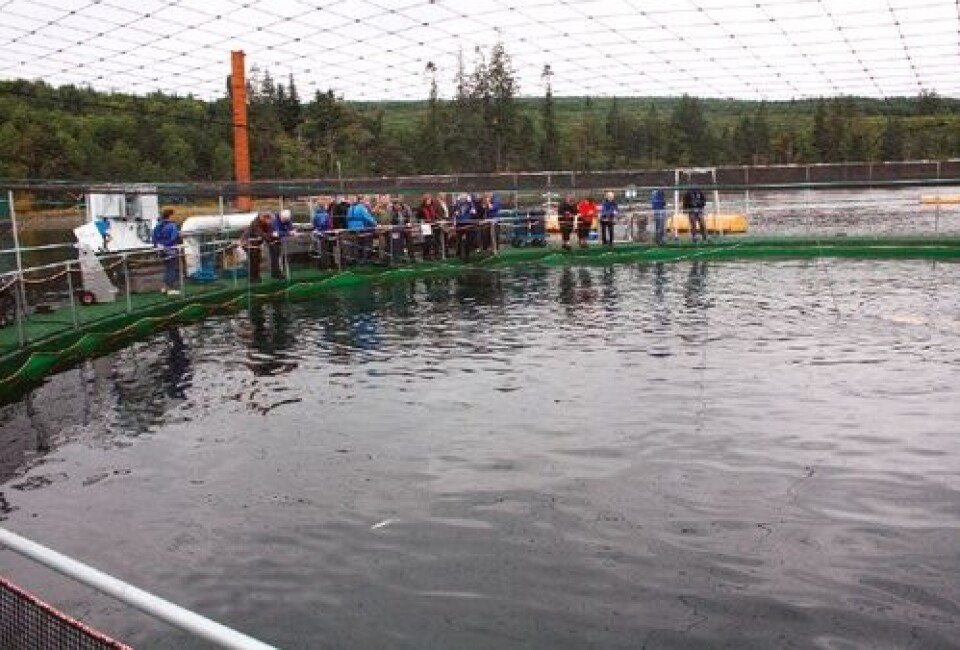Still no scientifically sound findings of the ISA virus in British Columbia or on the West Coast of USA. Canadian lab loses accreditation
Odd Grydeland odd@fishfarmingxpert.com
As previously reported in FishfarmingXpert, environmentalists and researchers from the Simon Fraser University (SFU) in Vancouver announced with great fanfare on October 17, 2011 that ISA had been detected in two of 48 samples of dead salmon picked up from a watershed north of Vancouver Island and they asserted that this virus is “highly contagious and lethal”, “of the European strain”, and that “the only plausible source of this virus is fish farms”. This statement by salmon farm critic Alexandra Morton and SFU professor Rick Routledge was made despite the fact that by that time over 4,700 farmed salmon from British Columbia had been assessed and found to be negative for ISA. If there had been a “highly contagious and lethal” ISA virus on B.C. fish farms, surely somebody would have noticed. All of the major salmon farming companies employ veterinarians and other fish health personnel, and ISA is one of the diseases that must be reported to government agencies.

The positive finding announced by Ms. Morton and professor Routledge was reported to Canadian authorities by Dr. Fred Kibenge of the Atlantic Veterinary College’s laboratory in Prince Edward Island- at the time one of only two facilities approved by the World Organization for Animal Health as a reference laboratory for the ISA virus. Following his findings, the remaining samples of the 48 fish were sent to two other laboratories- none of which could confirm Dr. Kibenge’s results. More about the AVC lab later. It is not the first time Ms. Morton- who has received and honourary doctorate from SFU but who doesn’t have any formal education in either fish pathology or fish biology- has been crying wolf by misinterpreting scientific information only to be corrected by government scientists; • Back in 1998 Alexandra Morton wrote an article in a B.C. Newspaper stating that “Fish farms devastate the environment: Salmon, whales birds vanish as depredations of aquaculture spread”. As an example of this devastation, Ms. Morton said in her article that an autopsy of a dead killer whale found a couple of years earlier showed the animal to be “full of antibiotic resistant bacteria originating from farmed salmon”. In a subsequent letter to the same paper dated November 25, 1998 the Chief Veterinarian from the B.C. Ministry of Agriculture and Food, R. J. Lewis, DVM, MVSc wrote about Ms. Morton’s article among else that “There is much unsubstantiated information in this article relating to fish farms but I would like to confine my comments to one point made by Ms. Morton. Since I was ‘the doctor who performed the autopsy’ allow me to present some facts related to the whale autopsy. The animal was not “full of antibiotic resistant bacteria” but succumbed to a generalized infection due to a bacteria, Erysipelothrix rhusiopathiae, commonly present in the marine environment; this organism is well known to exist in the slime of herring and other wild fish. Dr. Lewis continued to say that “There is no basis to suggest the agent originated from farmed salmon; in fact, the provincial veterinary diagnostic laboratory in Abbotsford has never recovered Erysipelothrix rhusiopathiae from farmed fish. As a veterinary pathologist, I have examined tissues from many other free ranging killer whales and am unaware of whales dying due to ‘antibiotic-resistant disease’.” One week after Dr. Lewis’ letter appeared in the newspaper, Ms. Morton repeated her claim that the whale had been killed by fish farms on a Vancouver radio station.

• In April, 2003 Ms. Morton said during an interview with a Vancouver radio station that (farmed in B.C.) Atlantic salmon are infected with IHN (Infectious Haematopoietic Necrosis)- “an infectious virus of the rabies family”. This statement prompted Dr. Garth Traxler, a virologist with the Canadian Department of Fisheries and Oceans to write to Ms. Morton, stating that her statement “is imprecise and could create unfounded confusion and fear in the public mind. Within the rhabdovirus family there are several groups and genera. One of these is the lyssavirus group which is comprised of rabies and related viruses and only affect warm-blooded mammals. IHN virus is in separate group called the novirhabdovirus and viruses in this group affect cold-blooded fish. The name rhabdovirus is derived from the term ‘rhabdos’ meaning bullet shaped- a characteristic shared by both viruses. The rhabdovirus family is one of the largest groups of viruses. There are hundreds and maybe thousands of rhabdoviruses as yet undiscovered infecting many different host species from plants to humans”. Dr. Traxler concludes his letter to Ms. Morton stating that “To try to draw an analogy between the two very different viruses because they are in the same family serves no purpose other than unnecessarily alarm members of the public”.

The reportedly positive ISA findings of the Atlantic veterinary College (AVC) at the prince Edward Island University was at the time described by a B.C. fish veterinarian as ‘identifying 0.01% of a finger print’, and the Canadian government committed to ‘investigate claims about the presence of the disease, the timeline of test results, and the proper, science-based requirements for testing’. Officials also indicated that ‘there will be investigations into the collection, handling, transportation and storage of samples by other sources that led to the original claims’. According to a November, 2012 article by the Canadian Press, in November 2011, B.C.’s then chief veterinary officer Paul Kitching told reporters that anyone who said the (ISA) virus was present in the Province, based on results from the PEI lab, was misrepresenting the science. “I can also say that as editor-in-chief of an international veterinary journal, this would be considered poor science and not likely publishable”. The Paris, France based World Organization for Animal Health known as the OIE, publishes a new version of the Aquatic Animal Health Code every year. In the latest version (Fifteenth Edition), the code describes some of the ‘Critical elements of surveillance (a systematic series of investigations of a given population of aquatic animals to detect the occurrence of disease for control purposes, and which may involve testing samples of a population) which includes a section on Data collection and management, and state that ‘Factors influencing the quality of collected data include; a) the distribution of, and communication between, those involved in generating and transferring data from the field to a centralised location; b) motivation of the people involved in the surveillance system; c) the ability of the data processing system to detect missing, inconsistent or inaccurate data, and to address these problems; d) maintenance of disaggregated data rather than the compilation of summary data; e) minimisation of transcription errors during data processing and communication. The Code also states that ‘the sampling method used at all stages should be fully documented and justified’ and that people or organizations involved in Aquatic Animal Health Services ‘are normally accredited or approved by the Competent Authority (government) to deliver the delegated functions’. It is safe to say that Ms. Alexandra Morton does not enjoy such accreditation or approval by either British Columbia or Canada.

Regarding the Quality of Aquatic Animal Health Services, the OIE Code describes some of the Fundamental principles of quality and states that ‘Aquatic Animal Health Services should comply with the following principles to ensure the quality of their activities’ (the 5 first of 14 principles): 1. Professional judgement Aquatic Animal Health Services should ensure that personnel have the relevant qualifications, scientific expertise and experience to give them the competence to make sound professional judgements. 2. Independence Care should be taken to ensure that the Aquatic Animal Health Service personnel are free from any commercial, financial, hierarchical, political or other pressures which may inappropriately influence their judgement or decision. 3. Impartiality Aquatic Animal Health Services should be impartial. In particular, all the parties affected by their activities have a right to expect their services to be delivered under reasonable and non-discriminatory conditions. 4. Integrity Aquatic Animal Health Services are responsible for ensuring that the work of each of their personnel is of a consistently high level of integrity. Any fraud, corruption or falsification should be identified, documented and corrected. 5. Objectivity Aquatic Animal Health Services should conduct themselves, in an objective, transparent and non-discriminatory manner. According to a blog posting by farmfreshsalmon.org, the lab that “found” the ISA virus (Dr. Kibenge’s AVC facility at the UPEI) ‘has been criticized in the past for producing an abnormal number of “false positive” test results’. When the facility received national and international attention following the announcement by Ms. Morton and SFU professor Routledge that the ISA virus had been found in fish samples from British Columbia, the Canadian Food Inspection Agency (CFIA)- which is responsible for fish health in Canada- conducted an audit of the laboratory. Following the audit, Dr. Kibenge stated to a commission established in B.C. to investigate an unexpectedly small run of sockeye salmon to the Fraser River that ‘officials were attacking his reputation and trying to discredit his work during the CFIA audit’ (Canadian Press). “Based on the questioning I got, I sensed that the interest here was to confirm my result was the result of contamination. The second point was that probably I was doing shoddy science” he said.

In a statement issued earlier this month, CFIA said that ‘Because any suspected cases of ISA must be confirmed at a designated federal laboratory, the National Aquatic Animal Health Laboratory, overseen by Fisheries and Oceans Canada (DFO), conducted testing of fish samples (from the B.C. fish that were reported by Ms. Morton and SFU professor Routledge to be positive for ISAV- ed. note). The positive test results reported by the AVC were not corroborated by the DFO laboratory. Due to the differences observed in these test results, the CFIA conducted evaluations of both laboratories to assess their capability to reliably detect the ISA virus in accordance with accepted scientific standards. The evaluation conducted at the AVC identified concerns, which may have led to the questionable ISA test results. This information was shared with the OIE’. The statement from CFIA continues: ‘The OIE designates reference laboratory status based on a laboratory’s ability to maintain the highest technical and operational standards. The OIE undertook an independent audit of the AVC after another OIE member country also reported issues related to ISA test results from this laboratory. The OIE audit, performed by an international panel of scientific experts, found a series of weaknesses affecting the quality of diagnoses performed at the AVC laboratory. The decision to delist this laboratory as an OIE reference laboratory was approved unanimously by the General Assembly of the OIE in May 2013’. In February last year, CFIA announced that it was initiating a multi-year surveillance program for diseases in wild salmon in British Columbia. The statement including a reference to salmon farms; ‘For farmed fish, the CFIA is currently conducting a quantitative evaluation of on-going testing initiatives in farmed populations. The requirements for additional surveillance in farmed fish will be established upon the completion of this evaluation‘. In B.C., all salmon farms must operate with an approved Fish Health Management Plan that includes monthly reporting of all fish health events, including the occurrence of disease. During recent years, over 4,700 farmed fish have been tested for the presence if ISA virus, and all have been negative. The result of the first year of sampling of wild fish in B.C. was announced last month (June, 2013); ‘The Canadian Food Inspection Agency (CFIA) has completed its first year of wild anadromous salmonid sampling in British Columbia. The sampling is part of the Agency’s initial efforts to determine the health status of wild salmon in British Columbia through testing for the causal agents of three infectious diseases—infectious haematopoietic necrosis virus (IHNV), infectious pancreatic necrosis virus (IPNV), and infectious salmon anaemia virus (ISAV). Although none of the diseases pose a risk to human health, they are contagious among certain finfish species and can cause mortality. IHNV is known to exist in certain species and populations of wild finfish in British Columbia, whereas IPNV and ISAV have not been confirmed in the province. A total of 4175 fish were collected and tested in 2012. All of the samples were tested for ISAV, 3614 for IPNV and 561 for IHNV. All samples collected and tested were negative’. In May this year, the Washington State Department of Fish and Wildlife (WDFW) issued a statement saying that it had conducted tissue sampling of more than 900 wild and hatchery-produced Pacific chinook, coho, sockeye, chum and steelhead, as well as farm-raised Atlantic salmon, and all samples were found negative for ISA by two separate laboratories. ‘ISAV has not been documented in farmed, wild or hatchery salmon in Washington’ said the release. John Kerwin, Fish Health Program manager for the WDFW said that “Our traditional testing protocols would have detected most- but not all- of the disease-causing strains of ISA virus. So we expanded our program to better detect whether any strains is present in a variety of fish species in Washington. The good news is all the samples came back negative for the virus”. Professor Atle G. Guttormsen at the Institute for Economy and Resource Management at the University for Environment and Biosciences at Ås in Norway wrote in IntraFish about Ms. Morton that “she has a clear agenda and has definitely not the truth-seeking curiosity that should characterize a good researcher”. Ms. Morton is a co-author of a recently published paper about a piscine reovirus in B.C. apparently also found by the AVC laboratory. More about that in a later issue of FishfarmingXpert.























































